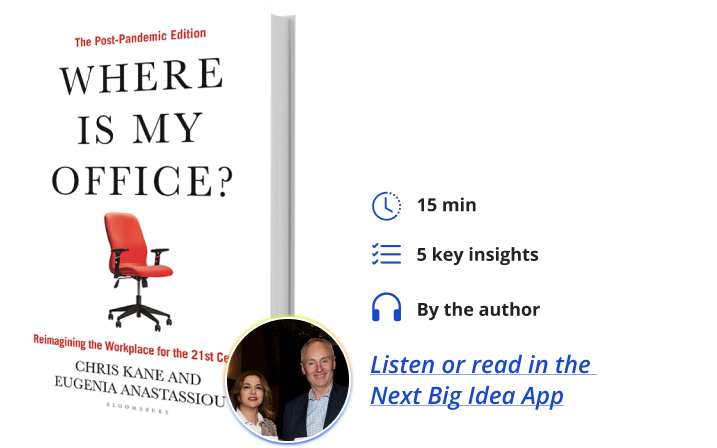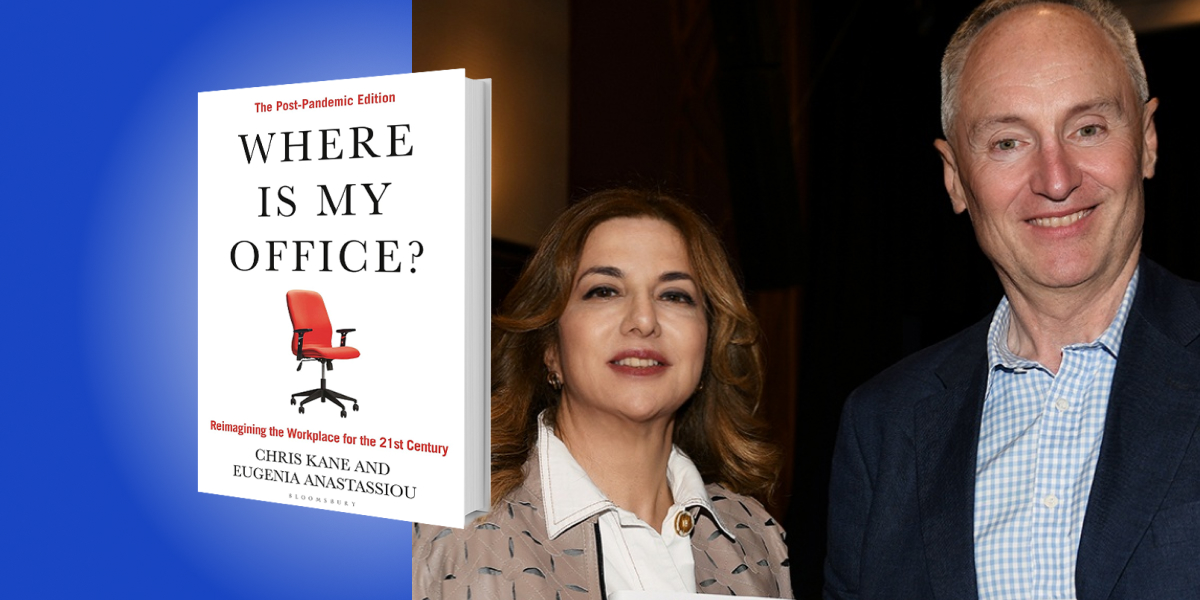Chris Kane has worked in commercial real estate for over 30 years, having held senior positions in global firms such as JLL, the Walt Disney Co., and the BBC. He is uniquely placed because his career has spanned the role of both providing real estate and being on the client side, plus working in both the public and private sectors. This has given him the ability to see both sides of the landlord and tenant world.
Eugenia Anastassiou has a background in journalism and is an editor at EverythingOmni. Her writing takes a special interest in business and emerging technologies
Below, co-authors Chris and Eugenia share 5 key insights from their new book, Where Is My Office?: The Post-Pandemic Edition. Listen to the audio version—read by Chris and Eugenia—in the Next Big Idea App.

1. Consumer choice has hit bosses and landlords.
Consumer choice has been a feature of the wider economy for some time now. But it’s taken a pandemic to bring it into the narrow world of commercial real estate, and indeed into the world of office employers. Not only has the entire game changed, but the entire stadium has changed.
For over a hundred years, since large-scale offices started to emerge, it was a given that if you are an office worker you have to go to the office. It was non-negotiable. But because of the pandemic, when everyone was forced to experiment with working from home, many bosses were surprised that productivity levels weren’t negatively affected. So, commuting became a choice rather than a chore.
Similarly, in terms of the real estate world, landlords presumed that their tenants had no choice and that corporations would always need a physical space. Even before the pandemic that was starting to change with the arrival of flexible office providers, such as WeWork. Bosses began to realize that we could consume space differently rather than having to buy a building or take a long lease commitment.
The relationships between bosses and workers, and bosses and landlords in this novel situation call for fresh perspectives.
2. Multidimensional modes of connection have affected how we work.
Long-established, seemingly permanent beliefs have been upended by the pandemic. The notion that we live somewhere in the suburbs and commute to our desks is no longer a given. During the dreadful period when we were locked down across the world, we all had to employ necessity as the mother of all invention. With that, we found that there are alternatives to things we presumed had to be face-to-face, such as doctor’s appointments, school classes, and office workdays.
Many people started to wonder, Why would I commute just to sit at a desk, sending emails? Who would have thought that both our grandparents and our grandchildren would be equally comfortable with Zooms and Teams—terms that are now part of common parlance? We’re seeing the emergence of a new model of work. Possibly a four-day week, or other permutations we have yet to realize.
“Many people started to wonder, Why would I commute just to sit at a desk, sending emails?”
This has significant implications for commercial real estate. Take, for example, San Francisco or downtown Manhattan. There have been significant vacancies. Will people ever go back to the office?
We can still do all these things in person which we had adapted to remote living, but we now realize we have viable alternatives to choose from. This has significant implications and has helped us better understand the links between people and place.
3. Covid removed the last obstacles to a truly digital way of life.
We are still amid lots of ships from the old analog world, but Covid accelerated crossovers to the new digital world. Everyone uses Zoom and Teams, but we’re only beginning to understand what the true implications of the new status quo. We’ve been on a journey for the last 20 years moving away from analog but many of the digital opportunities pre-Covid just weren’t sticking because (whether you were a boss, landlord, office worker, or policy maker) human nature said, We just don’t know how to cope with all of this stuff.
As a result of having to cope with the challenges of relying on technology to better connect during lockdown, we’ve discovered that we can do things differently. For instance, for many businesses, post-pandemic work brought the death of paper. Lawyers now accept digital signatures. Everyone is much more comfortable with PDF versions rather than hard copies. Think about how many filing cabinets you don’t need anymore. That’s just a small tip of the iceberg.
Many young people are coming into the workforce who are complete digital natives. They don’t need pencil and paper. We don’t quite understand yet what the true implications of this new work culture are and our current moment is a period of experimentation.
4. Hybrid and flexible styles of working are here to stay.
Many people in the media talk about hybrid as if it is a new invention. Hybrid has been around for decades but only came to the mainstream following the globally-enforced work-from-home experiment. Blended may be a better description for the mix of working in the mothership office, at home, and from a range of other workspaces.
We’re still fixated on having one place of work. Events are proving that work is becoming more and more multidimensional. It’s not a binary choice between the mothership office or working from home. For years we’ve been talking about third spaces, such as cafes and restaurants, and now we see a rise in local work hubs. Similar to what happened in the retail sector with the birth of omnichannel marketing roughly a decade ago, we are going to see changes as a result of what we label as omniworking.
“The nine-to-five model is in its last chapter.”
Omniworking is a mix of fixed, flex, and fluid components. Physical offices will be the fixed component. You may also have flexible bases of operations through WeWork, Regus, IWG, or the like. But also, you will have fluid components, such as work hours. The nine-to-five model is in its last chapter. We’re seeing more people experimenting with the metaverse and now industries are grappling with the introduction of ChatGPT. What’s that going to do to organizations and how they structure themselves? There will be a whole heap of new jobs, as well as a reduction in overall footprint and greater reliance or interest matters which fall into the fluid side of things. We’re looking at a truly multidimensional proposition here.
5. What should business leaders do to navigate this transition?
The new normal is a nightmare for bosses and the real estate industry, who have relied upon tried-and-tested models and templates for how to do things. For those of us born in the 20th century, we’re accustomed to homogenous, one-size-fits-all thinking. That’s gone out the window. We are seeing a new model of office working emerging that will be based on a fixed-flex-fluid spectrum. We need to join the dots between all of siloed thinking of people, place, leadership, and technology. We’re in the world of experimentation.
Maybe when the history books are written about this period, they will describe it as the 21st century Workplace Renaissance. Or possibly the uberization of work and of the workplace. If we accept that one-size-fits all is over, then we need to experiment and start asking the right questions. We need to think about shifting focus beyond profit and towards purpose. We need to consider focusing more on stakeholder value than purely shareholder value. Maybe shift our thinking from return on cost to one based on a return on people.
It’s time to make smarter use of building environments to accommodate a more humancentric workplace. Business leaders must move to a model where engagement, flexibility, authenticity, and sustainability are evident. Without this transition, they will fail to attract and retain the talent they require to become the employers of choice and gain an advantage over competitors. After all, people are a business’s most valuable resource and ultimately, their engagement with their working environment is paramount to an organization’s success.
To listen to the audio version read by co-authors Chris Kane and Eugenia Anastassiou, download the Next Big Idea App today:































